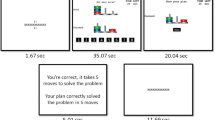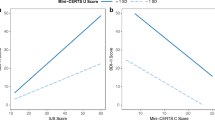Abstract
Depressive realism consists of the lower personal control over uncontrollable events perceived by depressed as compared to nondepressed individuals. In this article, we propose that the realism of depressed individuals is caused not by an increased accuracy in perception, but by their more comprehensive exposure to the actual environmental contingencies, which in turn is due to their more passive pattern of responding. To test this hypothesis, dysphoric and nondysphoric participants were exposed to an uncontrollable task and both their probability of responding and their judgment of control were assessed. As was expected, higher levels of depression correlated negatively with probability of responding and with the illusion of control. Implications for a therapy of depression are discussed.
Similar content being viewed by others
References
ACKERMANN, R., & DERUBEIS, R. J. (1991). Is depressive realism real? Clinical Psychology Review, 11, 565–584.
AESCHLEMAN, S. R., ROSEN, C. C, & WILLIAMS, M. R. (2002). The effect on non-contingent negative and positive reinforcement operations on the acquisition of superstitious behaviors. Behavioural Processes, 61, 37–45.
ALLAN, L. G., SIEGEL, S., & HANNAH, S. (2007). The sad truth about depressive realism. Quarterly Journal of Experimental Psychology, 60, 482–495.
ALLOY, L. B., & ABRAMSON, L. Y. (1979). Judgment of contingency in depressed and non-depressed students: Sadder but wiser? Journal of Experimental Psychology: General, 108, 441–485.
ALLOY, L. B., & CLEMENTS, C. M. (1992). Illusion of control: Invulnerability to negative affect and depressive symptoms after laboratory and natural stressors. Journal of Abnormal Psychology, 101, 234–245.
BECK, A. T. (1967). Depression: Clinical, experimental, and theoretical aspects. New York: Harper & Row.
BECK, A. T., WARD, C.L.L, MENDELSON, M., MOCK, J., & ERBAUGH, J. (1961). An inventory for measuring depression. Archives of General Psychiatry, 4, 561–571.
BIRNBAUM, M. H. (Ed.). (2000). Psychological experiments on the Internet. San Diego, CA: Academic Press.
BUCHANAN, T., & SMITH, J. L. (1999). Using the Internet for psychological research: Personality testing on the World Wide Web. British Journal of Psychology, 90, 125–144.
CONDE, V., ESTEBAN, L., & USEROS, E. (1976). Adaptaciôn castellana de la escala de evaluaciôn conductual para la depresiôn de Beck [Spanish adaptation of Beck’s depression inventory]. Revista de Psicologia General yAplicada, 31, 496–497.
ELLIS, A. (1962). Reason and emotion in psychotherapy. Secaucus, NJ: Lyle Stuart.
FORCAS, J. P. (1998). On being happy and mistaken: Mood effects on the fundamental attribution error. Journal of Personality and Social Psychology, 75, 318–331.
FRANKEL, M. S., & SIANG, S. (1999). Ethical and legal aspects of human subjects research in cyberspace. Report of a workshop convened by the American Association for the Advancement of Science, Program on Specific Freedom, Responsibility, and Law, Washington, Dc. Retrieved May 9, 2005, from http://www.aaas.org/spp/dspp/sfrl/projects/intres/main.htm.
GOSLING, S. D., VAZIRE, S., SRIVASTAVA, S., & JOHN, O. P. (2004). Should we trust Web-based studies? A comparative analysis of six preconceptions about Internet questionnaires. American Psychologist, 59, 93–104.
HAAGA, D. A. F., & BECK, A. T. (1995). Perspectives on depressive realism: Implications for cognitive theory of depression. Behavior Research and Therapy, 33, 41–48.
KRAUT, R., OLSON, J., BANAJI, M., BRUCKMAN, A., COHEN, J., & COUPER, M. (2004). Psychological research online: Report of board of scientific affairs’ advisory group on the conduct of research on the Internet. American Psychologist, 59, 705–717.
LANGER, E. J. (1975). The illusion of control. Journal of Personality and Social Psychology, 32, 301–328.
LEWINSOHN, P. M. (1974). A behavioral approach to depression. In R. J. Friedman & M. M. Katz (Eds.), The psychology of depression: Contemporary theory and research (pp. 776–778). Washington, DC: Wiley.
LEWINSOHN, P. M., SULLIVAN, J. M., & GROSSCUP, S. J. (1980). Changing reinforcement events: An approach to the treatment of depression. Psychotherapy: Theory, Research, and Practice, 17, 322–333.
MATUTE, H. (1994). Learned helplessness and superstitious behavior as opposite effects of uncontrollable reinforcement in humans. Teaming and Motivation, 25, 216–232.
MATUTE, H. (1995). Human reactions to uncontrollable outcomes: Further evidence for superstitions rather than helplessness. Quarterly Journal of Experimental Psychology, 48B, 142–157.
MATUTE, H. (1996). Illusion of control: Detecting response-outcome independence in analytic but not in naturalistic conditions. Psychological Science, 7, 289–293.
MATUTE, H., VADILLO, M. A., & BÂRCENA, R. (2007). Web-based experiment control software for research and teaching on human learning. Behavior Research Methods, 3, 689–693.
MATUTE, H., VADILLO, M. A., BLANCO, F., & MUSCA, S. C. (2007). Either greedy or well informed: The reward maximization-unbiased evaluation trade-off. In Proceedings of the Second European Cognitive Science Conference (pp. 341–346). Mahwah, NJ: Erlbaum.
MATUTE, H., VADILLO, M. A., VEGAS, S., & BLANCO, F. (2007). Illusion of control in Internet users and college students. Cyberpsychology & Behavior, 10, 176–181.
MSETFI, R. M., MURPHY, R. A., & SIMPSON, J. (2007). Depressive realism and the effect of inter-trial interval on judgments of zero, positive, and negative contingencies. Quarterly Journal of Experimental Psychology, 60, 461–481.
MSETFI, R. M., MURPHY, R. A., SIMPSON, J., & KORNBROT, D. E. (2005). Depressive realism and outcome density bias in contingency judgments: The effect of the context and inter-trial interval. Journal of Experimental Psychology: General, 134, 10–22.
PLAUD, J. J., & EIFERT, G. H. (1998). From behavior theory to behavior therapy. Boston: Allyn & Bacon.
REHM, L. P. (1977). A-self control model of depression. Behavior Therapy, 8, 787–804.
REIPS, U-D. (2002). Standards for Internet-based experimenting. Experimental Psychology, 49, 243–256.
RUDSKI, J. M. (2000). Effect of delay of reinforcement on superstitious inferences. Perceptual and Motor Skills, 90, 1047–1058.
RUDSKI, J. M., LISCHNER, M. I., & ALBERT, L. M. (1999). Superstitious rule generation is affected by probability and type of outcome. The Psychological Record, 49, 245–260.
SCHWARTZ, B. (1981). Does helplessness cause depression, or do only depressed people become helpless? Comment on Alloy and Abramson. Journal of Experimental Psychology: General, 110, 429–435.
SELIGMAN, M. E. P. (1975). Helplessness. San Francisco: Freeman.
SHANKS, D. R., & DICKINSON, A. (1987). Associative accounts of causality judgment. In G. H. Bower (Ed.), The psychology of learning and motivation (Vol. 21, pp. 229–261). San Diego, CA: Academic Press.
SKINNER, B. F. (1948). “Superstition” in the pigeon. Journal of Experimental Psychology, 38, 168–172.
SKINNER, E. A. (1985). Action, control judgments and the structure of control experience. Psychological Review, 92, 39–58.
STADDON, J. E. R., & SIMMELHAG, V. L. (1971). The “superstition” experiment: A reexamination of its implications for the principles of adaptive behavior. Psychological Review, 78, 3–43.
STEYVERS, M., TENENBAUM, J. B., WAGENMAKERS, E. -J., & BLUM, B. (2003). Inferring causal networks from observations and interventions. Cognitive Science, 27, 453–489.
TAYLOR, S. E., & BROWN, J. D. (1988). Illusion and well-being: A social psychological perspective on mental health. Psychological Bulletin, 103, 192–210.
THOMPSON, S. C, ARMSTRONG, W., & THOMAS, C. (1998). Illusions of control, underestimations and accuracy: A control heuristic explanation. Psychological Bulletin, 123, 146–161.
VADILLO, M. A., BÂRCENA, R., & MATUTE, H. (2006). The Internet as a research tool in the study of associative learning: An example from overshadowing. Behavioural Processes, 73, 36–40.
VADILLO, M. A., & MATUTE, H. (2007). Predictions and causal estimations are not supported by the same associative structure. Quarterly Journal of Experimental Psychology, 60, 433–447.
WARD, W C, & ENKINS, H. M. (1965). The display of information and the judgment of contingency. Canadian Journal of Psychology, 19, 231–241.
WASSERMAN, E. A. (1990). Detecting response-outcome relations: Toward an understanding of the causal texture of the environment. In G. H. Bower (Ed.), The psychology of learning and motivation (Vol. 26, pp. 27–82). San Diego, CA: Academic Press.
Author information
Authors and Affiliations
Corresponding author
Additional information
Support for this research was provided by Dirección General de Investigación of the Spanish Government (Grant SEJ2007–63691/PSIC), Departamento de Educación, Universidades e Investigación of the Basque Government (Grant PI2008–9), and Dirección General de Investigación, Tecnología y Empresa of the Junta de Andalucía (Grant SEJ–406). Fernando Blanco was supported by fellowships BFI081.020.0 and BFI04.484 from Gobierno Vasco. He is now at the University of Leuven, Belgium. We thank Gumersinda Alonso, Esther Calvete, Francisco J. López, Rachel Msetfi, Dominique Muller, Robin Murphy, Serban C. Musca, Cristina Orgaz, Juan M. Rosas, and David Watson for their valuable comments and discussions on preliminary versions of this article.
Rights and permissions
About this article
Cite this article
Blanco, F., Matute, H. & Vadillo, M.A. Depressive Realism: Wiser or Quieter?. Psychol Rec 59, 551–562 (2009). https://doi.org/10.1007/BF03395681
Published:
Issue Date:
DOI: https://doi.org/10.1007/BF03395681




